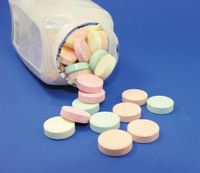propofol
Our editors will review what you’ve submitted and determine whether to revise the article.
- MedicineNet - Propofol
- Cleveland Clinic - Propofol injection
- Mayo Clinic - Propofol (Intravenous Route)
- Drugs.com - Propofol
- Verywell Health - How Do They Wake You Up From Propofol?
- Harvard Health Publishing - Propofol: the drug that killed Michael Jackson
- American Society of Anesthesiologists - Anesthesiology - Propofol
- National Center for Biotechnology Information - Propofol
- Related Topics:
- intravenous anesthetic
propofol, anesthetic drug used to induce and maintain general anesthesia and to sedate patients for certain medical procedures. Propofol was first tested clinically in 1977. When administered by intravenous injection, it quickly induced anesthesia, with fast and smooth recovery afterward. Animal studies, however, revealed the potential for severe allergic reactions. With subsequent reformulation of propofol into an oil-based emulsion, giving it a milky appearance, this challenge was overcome, and propofol gained widespread use as a key anesthetic agent.
As a general anesthetic, propofol initially is given at a relatively high dose to produce a loss of consciousness in the patient and then is infused continuously in smaller amounts to maintain an unresponsive state; this approach typically is used in patients who are undergoing major surgery. At lower doses, propofol acts as a conscious sedative (or procedural sedative), inducing a semiconscious state. The sedative effects set in and wear off quickly, making propofol an effective agent for inducing mild sedation in outpatient surgeries.
Side effects of propofol include pain at the injection site, hypotension, hypertension, nausea, cough, tingling sensation, and itching Rare side effects include arrhythmia, convulsion, and cardiac arrest. Propofol interacts with numerous other drugs, including chloral hydrate, diazepam, fentanyl, and morphine; such interactions can increase the anesthetic and sedative effects of propofol, producing potentially dangerous effects, such as cardiorespiratory depression and slowing of heart rate. Cardiac arrest caused by interaction between propofol and multiple benzodiazepines was responsible for the death of American singer and songwriter Michael Jackson in 2009.














